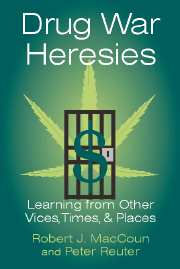Book contents
- Frontmatter
- Contents
- List of Figures and Tables
- Acknowledgments
- PART I OVERVIEW
- PART II THE ARGUMENTS
- PART III THE EVIDENCE
- 7 Other Vices: Prostitution and Gambling
- 8 Other Substances: Alcohol and Cigarettes
- 9 U.S. Experience with Legal Cocaine and Heroin
- 10 Learning from European Experiences
- 11 Cannabis Policies in The Netherlands
- 12 Harm Reduction in Europe
- PART IV ASSESSING THE ALTERNATIVES
- Bibliography
- Data Sources for Figures
- Author Index
- Subject Index
11 - Cannabis Policies in The Netherlands
Published online by Cambridge University Press: 24 May 2010
- Frontmatter
- Contents
- List of Figures and Tables
- Acknowledgments
- PART I OVERVIEW
- PART II THE ARGUMENTS
- PART III THE EVIDENCE
- 7 Other Vices: Prostitution and Gambling
- 8 Other Substances: Alcohol and Cigarettes
- 9 U.S. Experience with Legal Cocaine and Heroin
- 10 Learning from European Experiences
- 11 Cannabis Policies in The Netherlands
- 12 Harm Reduction in Europe
- PART IV ASSESSING THE ALTERNATIVES
- Bibliography
- Data Sources for Figures
- Author Index
- Subject Index
Summary
The first author was born in Michigan, where Dutch American communities carefully cultivate a tourist culture of wooden shoes, tulips, and windmills. Perhaps less intentionally, they have also cultivated a reputation for political and religious conservatism, if not intolerance. Thus, the walk down the Damrak from Amsterdam's “Centraal” train station still comes as a shock, even after numerous visits over two decades (and several years of residence in Berkeley). Large clusters of unkempt, scrawny junkies of indeterminate age sport dreadlocks and red-eyed, vacant stares. Sidewalk racks of postcards display lewd cartoons, full frontal nudity, prize strains of “Nederweed,” or hands extending lit joints with the phrase “Holland Has It!” Within a few blocks, there's a Sex Museum. Posters advertise a Hash Museum, a HempWorks Store, and the Annual Cannabis Cup trade fair. Not far away, churches and bakeries share city blocks with partially clothed prostitutes displaying their wares in storefront windows. It is easy to understand why many Americans return home to tell anyone who'll listen that “Holland is out of control.” Such impressions are further sensationalized by titillating accounts in the American media: most notoriously in Jonathan Blank's 1994 documentary film, Sex, Drugs, and Democracy.
It is true that Dutch drug policy is more explicitly tolerant than that of any other Western industrial nation, though few Americans realize that drugs are depenalized in both Italy and Spain.
- Type
- Chapter
- Information
- Drug War HeresiesLearning from Other Vices, Times, and Places, pp. 238 - 264Publisher: Cambridge University PressPrint publication year: 2001



